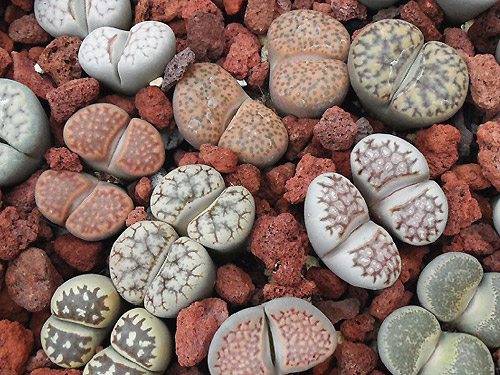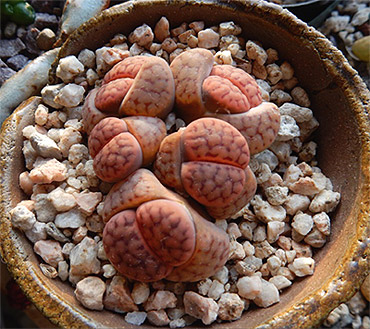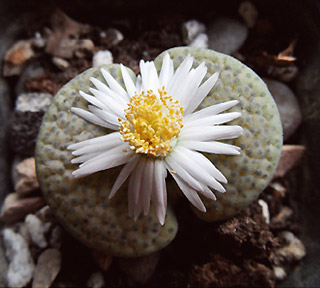Lithops (2020)

Text and Photos by Rita Taylor (November 2020)
Note: I am no lithops expert, just a lithops lover who tries to do what’s right for my plants. I am still learning and always eager to hear what both the experts and the experienced plant hobbyists have to say. I hope this information helps in your consideration of these little living stones.
I was first attracted to lithops because of all the varieties of color and pattern, and especially their small size. These compact cuties are just right for my collection. Low cost is another attraction. So the price is right if you are interested in trying your hand at raising some colorful little lithops.
Light
I do not have a greenhouse, nor do I use special grow lights on any of my plants. I agree with Mike Hellmann that lithops are best kept inside in the St. Louis area. I did try putting a few lithops outside on my covered front porch, which solved the rain issue, but I was concerned about the moisture in the air. Then finding a lithops with a bite out of it convinced me that all my lithops belonged inside. Squirrel attack?
My lithops get direct natural sunlight year-round in my southeast picture window. The plants do get less sun in the late afternoon and evening. During the warm to hot months, they are on the window sill itself. When we get very cold weather capable of temperatures below freezing, my lithops are moved back to the table in front of that same window. My lithops get the prime sun spots there. If your lithops get elongated, they are not getting enough light.
If you want to try your hand at lithops outside, check out Leo Chance’s series “Pushing the Limits: Landscaping With Cacti and Succulents in Cold Climates” in the Cactus and Succulent Journal of the Cactus and Succulent Society of America.

Watering
I use tap water that I allow to sit for a few days so that the chlorine evaporates. I used to go by the rule of “stop watering your lithops from Halloween to Easter,” but modified that to stop “regular” watering from Halloween to late March.
Since Easter has no set date, it can fall into mid-April, which is definitely too late to restart a watering schedule. I just do what seems to work for my plants. I do lose a few lithops off and on, but that seems to be true of any plant collection. At least, that’s what I tell myself!
From an expert at one of the cactus and succulent conferences, I also found out that lithops have fine hair roots coming off the main tap root that die if left completely unwatered for long periods. So now, during the dry season of Halloween to late March, I lightly spray my lithops every 10 to 20 days.
From late March to the end of October, I water my lithops approximately every 10 to 14 days. (If the temperature goes very high, I might lightly spray them in the “off” week.) I let the water run through until it comes out the bottom of the pots. I drain the excess water off by sitting the plants on newspaper and do not let them sit in water in a saucer.
One way to check if a plant’s soil is wet or dry is to stick a wooden skewer all the way down in the soil and leave it for a few minutes. If the skewer comes out totally dry, your plant is dry and needs water. If the wooden skewer is damp to the touch, my lithops have enough water. I do not want a totally saturated soil for lithops, so I do not want to see wet soil clinging to the stick.
For more on watering lithops, visit the Living Stones Nursery page at https://lithops.com/lithops/, which talks about another “dry period” for lithops during the hot summer until late summer or fall. The nursery tapers off regular watering again at this time. I have not tried this, but might in the future to see if my lithops respond better.

Soil
When I first started with lithops, I always kept them in the soil in which they came. Since they were happy – that is, alive – I was afraid to chance doing anything to upset them. I had been warned that lithops are hard to grow, so I was just excited that they were living.
Eventually, based on advice from some lithops experts, I realized that light and airy soil is great for lithops. So pumice is what I use when I transplant my lithops. Some lithops growers use a mix that is 50 percent pumice with the remainder composed of various “succulent” soils. Some people use their standard succulent soil mix for all their succulents, including lithops. Mainly you want soil that is porous and drains well.
In preparing for our cactus and succulent shows years ago, I was so leery of taking my lithops out of their original soil that I cut down the sides of their plastic pots and “buried” them in small, attractive clay pots to make them show-worthy. It worked; they got blue ribbons.
Now I transplant them into their show pots with fresh pumice, and that’s where they live from then on. Of course, I put a complementing top dressing on the surface for good looks and water retention.
Pots
I am still guilty of leaving some lithops in their original plastic pots and soil unless I choose them for show entries or think it is time for fresh soil. In habitat, lithops are flush with the ground, nearly hidden. When I transplant, I tend to somewhat lower them into the soil. If a lithops has a long tap root, it gets a taller container. So some of my lithops are in plastic, some live in beautiful ceramic and some are in cute little clay pots. My lithops have not shown a preference.
Air
Year-round, I run a standing floor fan at the lowest speed in the corner of my plant area for good air circulation.
Pests
I rarely see any type of pest on my lithops. I have seen possible signs of mealy bugs – very small white spots on an occasional plant. I treat these possible mealy bugs with alcohol on a cotton swab applied directly to the white spot, like I treat any of my plants with mealy bugs. If it is an actual bug, it turns gray or brown when touched with alcohol. If it is a speck of pumice or other material, it stays white. If you do get mealy bugs, check your plant daily and treat as often as necessary.

Proper Names
If a lithops does not come labeled with its proper name, it can be a challenge to find out the correct name. It is amazing how so many lithops with the same name can look so different. You can even see a group of a specific type that were “birthed” together, yet look so unalike! In order to name my lithops for show display, I pour through photos in books and online.
One of my favorites and one of the few distinctive lithops is L. dortheae, which often has a light grayish-tan body with a dark brown, mottled pattern that has red lines or splotches running through it. Even L. dortheae can be varied.
All in all, I love the rich variety of the seemingly unending colors and patterns of these little living stones. Sometimes, usually in the fall, they will even give you the gift of a large yellow or white flower that can almost completely hide the humble little plant from which it sprouted.
Books in the HSCSS Library
Lithops – David L. Sprechman – 1970
Lithops, Flowering Stones – Desmond Cole – 1988
Lithops, Treasures of the Veld – S. Hammer
Mesembs of the World – G. Smith, P. Cheaselet, E. Van Jaarsveld, H. Hartmann, S. Hammer, B. E. Van Wyck, P. Burgoyne, C. Klak and H. Kurzwell – 1998.
Also check out the 58-page 1986 booklet The New Growing the Mesembs, by Ed Storms. It includes 12 pages of color photos of lithops that can help with identification.
